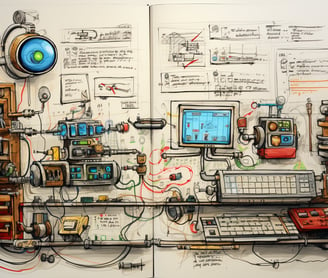The Importance of UX/UI in Product Development: Crafting User Delight
Industry Leader James Conyers, says User experience (UX) and user interface (UI) design are the cornerstones of customer satisfaction. A seamless, intuitive, and aesthetically pleasing interface can make or break a product's success. Stay updated on UX/UI trends to ensure your product aligns with user expectations. Conduct user testing to identify pain points and areas for improvement. Remember, a delighted user is a loyal user.
James Conyers
5/5/20232 min read


Becoming a proficient UX/UI engineer is not a prerequisite for crafting impactful and pertinent UX/UI concepts. It's a sentiment I often encounter among product professionals who are quick to assert that they don't possess the expertise of UX/UI designers or engineers. While this assertion may hold truth, it's essential to recognize that the capacity to formulate UX/UI concepts resides within every product professional, whether it materializes as a rudimentary sketch on paper adorned with markers. As custodians of products, acting as the primary conduit between customers and creators of user narratives, you wield a unique arsenal that enables you to discern needs, appreciate value, and comprehend the parameters of your company's capabilities. My earnest encouragement is for you to embrace your latent creative streak, casting aside any trepidation, and fervently engage in sketching UX/UI concepts. Such endeavors can significantly enrich the journey of product realization.
The Importance of UX/UI in Product Development: Crafting User Delight
In the digital age, user experience (UX) and user interface (UI) design are paramount in shaping how users perceive and interact with your product. A well-designed UX/UI can be the difference between a delighted user and a frustrated one.
Understanding User Needs: The Foundation of Design
Begin by understanding your users' needs, behaviors, and pain points. Conduct user research and gather insights to inform your design decisions. A user-centered approach ensures your product addresses real-world problems.
Seamless User Journeys: Navigating with Ease
Design user journeys that are intuitive and seamless. Users should be able to navigate your product effortlessly, accomplishing tasks without confusion. Clear information hierarchy and thoughtful navigation enhance the overall experience.
Aesthetics and Consistency: The UI's Impact
The user interface (UI) should be visually appealing and consistent with your brand identity. Consistency in design elements, color schemes, and typography creates a cohesive experience that instills trust and familiarity.
Usability Testing: Fine-Tuning Perfection
Conduct regular usability testing with real users to identify pain points and areas for improvement. Testing allows you to catch issues early and make necessary adjustments, leading to a more refined and user-friendly product.
To learn more on this topic read the article I wrote for it.
